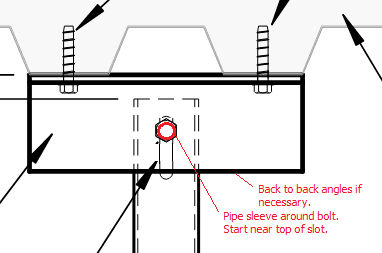See detail below for a general question I have. In the detail I am trying to brace the top of a new HSS column to the underside of an existing slab on metal deck. I don't want the slab or structure above to apply load to this new column. I am assuming that the floor above and the floor below that the column sits on both may deflect up to 1 1/2" for total live load deflection. So I'd like to have a connection that allows for 1 1/2" of upward and downward movement (3" total). Assuming I'm using a 3/4" diameter bolt, an AISC Long-Slot hole per the AISC manual is only 1 7/8" long. So that would not allow enough deflection. Am I OK to make the slot as long as I need if I'm only trying to transfer bolt shear forces in the perpendicular to slot direction? I see in section J3.10 of the AISC spec (2010) that the bearing strength for long-slotted holes loaded perpendicular to the slot is about 83% as strong as non long-slotted holes. So I assume a longer slot would reduce that even further, but I'm unsure if there's equations you can use to check the further reduced bearing strength? My reactions are low, so I feel like I could be OK.
Does anyone have any further guidance on what is OK and what is not OK for slotted holes that exceed an AISC standard long-slot? Would you do some other type of detail here that allows slip, but doesn't rely on a bolted connection?

Does anyone have any further guidance on what is OK and what is not OK for slotted holes that exceed an AISC standard long-slot? Would you do some other type of detail here that allows slip, but doesn't rely on a bolted connection?


